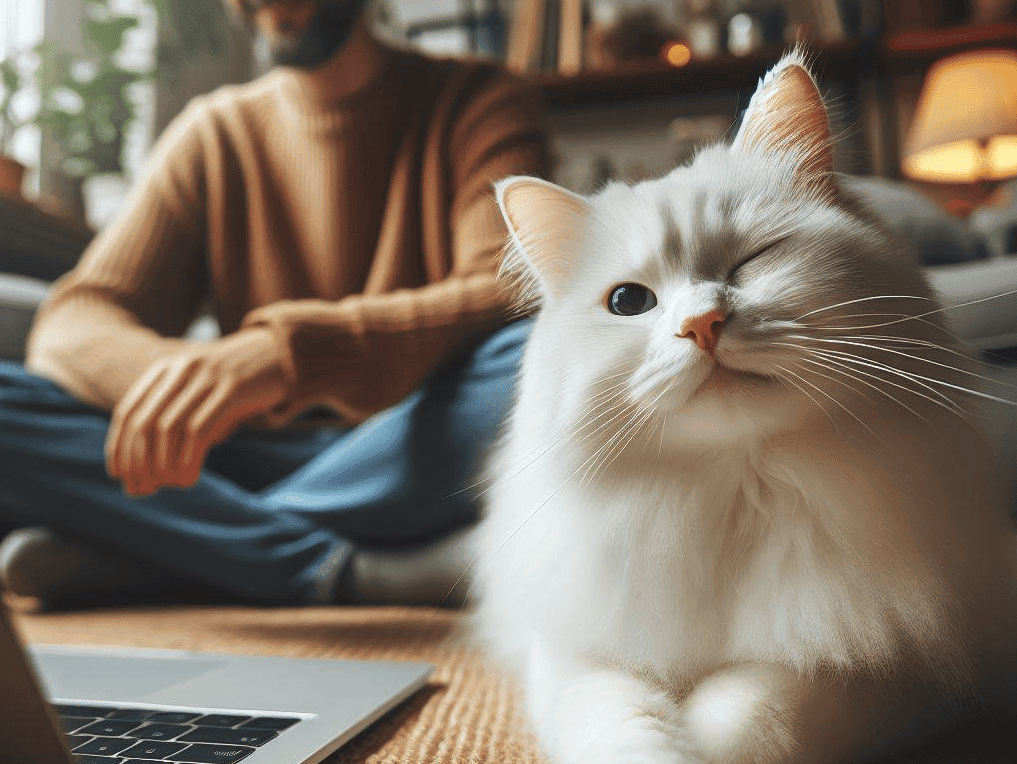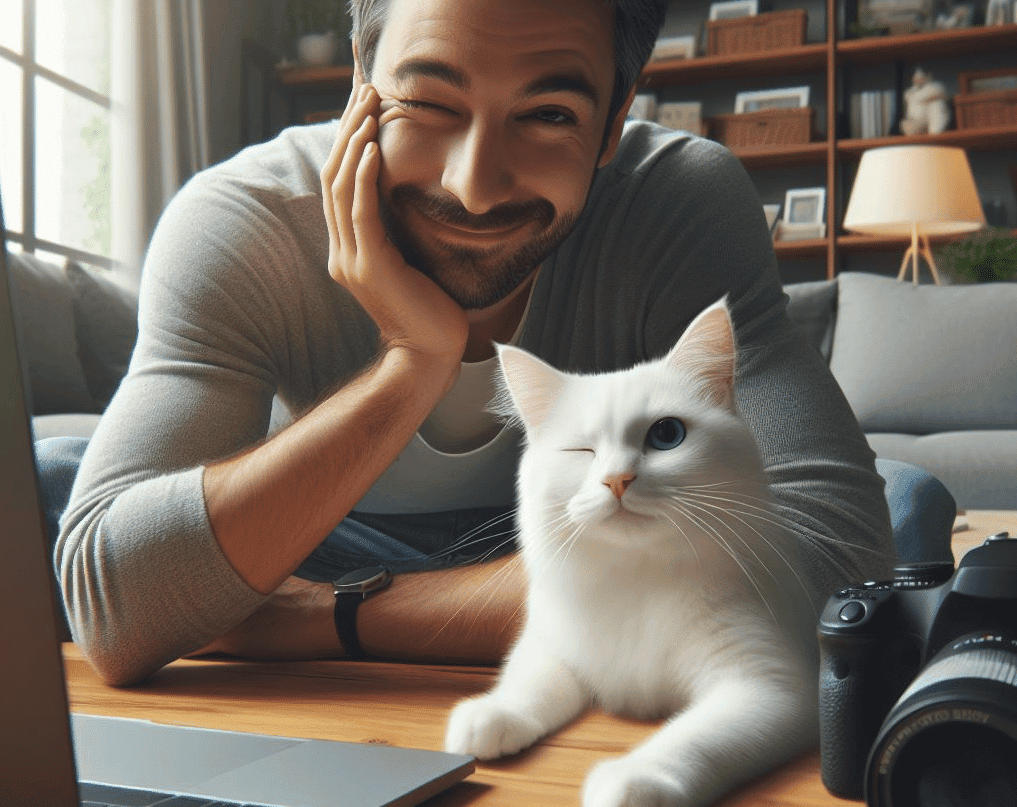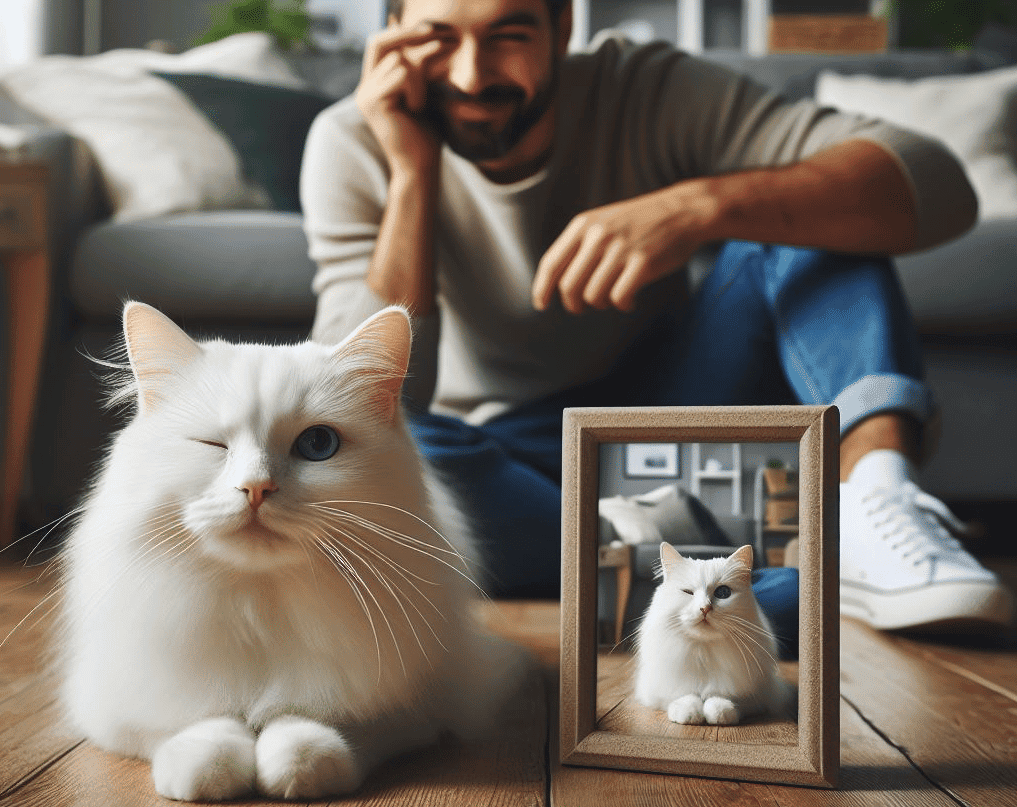
In this guide, I will explain why cats blink, especially with one eye, and what it could indicate about their health and well-being.
Cat eye blinking behavior is fascinating and can vary depending on the situation.
While occasional blinking is normal and harmless, excessive & persistent eye blinking may require veterinary attention.
Understanding the reasons can help you determine whether it’s a normal behavior or a cause for concern.
In a Nutshell
Cats may blink with one eye for several reasons, both normal and potentially indicative of a health issue. Blinking is a form of positive communication, where the cat signals trust and affection.
However, persistent one-eye blinking may also be a symptom of an eye infection, neurological condition, or other medical problem. A slow, affectionate blink with one eye can be a non-threatening social signal between the cat and its owner. If the blinking comes with other concerning symptoms, have the cat checked by a vet.
The “Slow Blink” Behavior in Cats
Cats have unique ways of communicating with us, one behavior that often stands out is the slow blink.
This is when a cat closes their eyes slowly and then opens them again.
It may seem like a simple gesture, but it holds a deep meaning in the feline world.
When a cat gives you a slow blink, it is a sign of trust and contentment.
It’s their way of saying, “I feel safe and relaxed with you.”
This behavior is often seen when a cat is in a state of calmness and comfort.
You can deepen the bond by reciprocating the slow blink.
The slow blink is considered a form of non-verbal communication, and it’s believed to be a way for cats to express their affection and recognition for their human companions.
It’s like a secret language between cats and their favorite humans, strengthening their connection and creating a sense of trust.
Try returning the gesture when your cat gives you a slow blink. Slowly close your eyes and open them again. This simple act can help to build a deeper bond with your feline friend and make them feel even more secure in your presence.
Understanding Unilateral Eye Blinking in Cats
In addition to the slow blink, cats also exhibit unilateral eye blinking, which is when they blink with only one eye.
This behavior can happen spontaneously or in response to external stimuli.
While the exact reasons behind unilateral eye blinking are not fully understood, it is believed to be a normal part of a cat’s behavior.
Unilateral eye blinking can occur due to various factors, including eye irritations, discomfort, or even just a quirk of their personality.
Try to observe your cat’s overall behavior and health to determine if the unilateral blinking is a cause for concern or simply a harmless behavior.
Doofy blinks a lot when he wants a second serving of his food. 😁
Remember, each cat is unique, and their eye blinking behavior may vary.
If you notice any persistent eye discomfort, excessive blinking, or other signs of eye irritation, it’s always best to consult a veterinarian for a proper diagnosis and appropriate treatment.
Cat Eye Blinking Behaviors |
Meaning |
|---|---|
| Slow Blink | Expression of trust and relaxation |
| Rapid Blinking | Possible indication of fear or discomfort |
| Unilateral Eye Blinking | Normal behavior but can be a sign of eye irritation if excessive or persistent |

Excessive Blinking and Eye Irritation in Cats
While some blinking is normal for cats, excessive blinking or ongoing eye irritation may indicate an underlying problem.
Cats can develop eye infections, injuries, allergies, and other conditions that can cause discomfort and increased blinking.
Suppose a cat’s eye is visibly irritated, swollen, or has bothered them for more than a day – it is important to seek veterinary attention to diagnose and treat the issue.
Common causes of eye discomfort and irritation in cats include:
- Allergies: Cats can be allergic to certain environmental allergens, such as pollen or dust mites, leading to eye irritation and excessive blinking.
- Infections: Eye infections, whether bacterial, viral, or fungal, can cause redness, swelling, and discomfort in cats, prompting them to blink excessively.
- Injuries: Trauma or foreign objects entering the eye can lead to injuries that result in blinking and eye discomfort.
If you notice any signs of persistent blinking, redness, swelling, or discharge, it is recommended to consult a veterinarian for a thorough examination and appropriate treatment.
Cause |
Symptoms |
|---|---|
| Allergies | – Excessive blinking – Redness and itching – Watery eyes |
| Infections | – Excessive blinking – Redness and swelling – Discharge – Rubbing at the eye |
| Injuries | – Excessive blinking – Swelling – Visible injury to the eye – Discomfort |
Depending on the underlying cause, treatment may include medication, eye drops, or other interventions to alleviate the cat’s discomfort and promote healing.
Understanding the Causes and Treatment
Feline eye infections are a common concern for cat owners, and understanding the causes and treatment options is essential in maintaining your cat’s ocular health.
If you notice symptoms such as excessive blinking, redness, swelling, or discharge in your cat’s eyes, you should seek veterinary attention for a proper diagnosis and appropriate treatment.
During an examination, the veterinarian will assess the overall health of your cat’s eyes, looking for signs of infection, inflammation, or other abnormalities.
They may also perform additional tests, such as taking swabs or samples for laboratory analysis, to determine the specific cause of the infection.
Once a diagnosis has been made, the veterinarian will prescribe the appropriate treatment plan for your cat’s eye infection.
This may include topical or oral medications, depending on the severity and underlying cause of the infection.
It’s important to follow the veterinarian’s instructions carefully and complete the full course of treatment routine.
Common Causes of Feline Eye Infections |
Symptoms |
Treatment Options |
|---|---|---|
| Injury | Excessive blinking, redness, swelling, discharge | – Topical or oral antibiotics – Pain management medications – Protective eyewear (if necessary) |
| Irritants | Excessive blinking, redness, itching, watering | – Flushing the eyes with sterile saline solution – Topical anti-inflammatory medications – Avoidance of known irritants |
| Underlying Health Conditions | Excessive blinking, redness, swelling, discharge, systemic symptoms | – Treatment of the underlying condition (e.g., allergies, respiratory infections) – Topical or systemic medications to manage the eye infection |
Preventing feline eye infections involves practicing good hygiene and keeping your cat’s environment clean.
Regularly clean your cat’s eyes with a damp cloth or specialized eye wipes to remove debris or discharge.
Avoid using strong chemicals or harsh substances near your cat’s eyes as they can irritate.
Additionally, keeping your cat’s vaccinations up to date and maintaining a healthy diet can help bolster their immune system and minimize the risk of infections.
Early detection and prompt treatment are essential in managing feline eye infections.

Preventing Eye Irritation from Allergies
While it may not be possible to eliminate your cat’s allergies, there are steps you can take to minimize their eye irritation and discomfort:
- Keep your cat’s living environment clean and free from dust and allergens.
- Use hypoallergenic bedding and consider using air purifiers to filter out allergens.
- Avoid using cleaning products, perfumes, or scented candles that may trigger allergic reactions.
- Consult with your veterinarian about potential dietary changes or hypoallergenic food options.
Third Eyelid Infections in Cats
Cats have a unique third eyelid that helps protect and moisturize their eyes.
However, this third eyelid can become infected, leading to serious eye problems.
When a cat’s third eyelid becomes infected, it may protrude and appear visibly swollen.
This condition requires immediate veterinary attention to prevent further complications and potential permanent eye damage.
Diagnosing third eyelid infections in cats usually involves a thorough examination by a veterinarian.
The vet will assess the visible symptoms and may perform additional tests to determine the underlying cause of the infection.
Depending on the specific infection treatment options may include prescribed medications, such as antibiotics or antiviral drugs.
Causes of Third Eyelid Infections in Cats
Several factors can contribute to third eyelid infections in cats.
Common causes include bacterial or viral infections, foreign objects in the eye, or injuries to the eye area.
Cats with weakened immune systems are more susceptible to developing these infections.
It’s important to note that third eyelid infections differ from normal blinking behavior and should not be ignored.
Causes of Third Eyelid Infections |
Symptoms |
Treatment |
|---|---|---|
| Bacterial or viral infections | Visible swelling of the third eyelid, redness, discharge | Prescribed medications (antibiotics or antiviral drugs) |
| Foreign objects in the eye | Excessive blinking, discomfort, visible irritation | Removal of the foreign object, prescribed medications |
| Injuries to the eye area | Visible trauma, bloodshot eyes, third eyelid protrusion | Treatment of the underlying injury, prescribed medications |
If you notice any unusual swelling or protrusion of your cat’s third eyelid, it’s crucial to seek veterinary care promptly.
Delaying treatment can lead to further complications and may potentially jeopardize your cat’s vision.

Respiratory Infections and Eye Issues in Cats
Respiratory infections in cats can sometimes lead to eye issues due to the interconnected nature of the respiratory system and the eyes.
When a cat develops a respiratory infection, such as an upper respiratory tract infection, it can cause inflammation and eye irritation.
This can result in watery eyes, redness, and discharge.
If your cat is experiencing respiratory symptoms and eye problems, it is important to seek veterinary care for proper diagnosis and treatment.
Respiratory Infections and Eye Issues in Cats |
Common Symptoms |
|---|---|
| Watery eyes | Nasal discharge |
| Redness | Sneezing |
| Discharge | Eye irritation |
Treatments may involve antibiotics or antiviral medications to combat the infection.
Eye drops or ointments may be provided to alleviate eye discomfort and promote healing.
Your veterinarian can provide specific recommendations based on your cat’s condition.
If you notice any signs of respiratory infections or eye problems in your cat, remember promptly to seek veterinary care.
Helpful Resource

In her previous life, Lisa traveled extensively, both for work and leisure. After the pandemic struck, Lisa locked up her luggage and adopted a cat ever since.
Lisa is now an avid cat lover, she devotes most of her free time serving as butler to her adorable feline at home. When she is not with her cat, she can be seen using her phone sourcing for the latest cat supplies online.


